Fairfax County is seeking public input on a new name and brand for Original Mount Vernon High School ahead of its redevelopment.
The county’s Department of Public Works and Environmental Services recently launched a survey that asks community members to consider feelings evoked by a new name, inspirations for the new name and themed word pairings.
The survey is available in English, Spanish and Arabic, and responses will be accepted until this Sunday, Feb. 11.
Mount Vernon District Supervisor Dan Storck says the Board of Supervisors doesn’t have any names in mind for the former school, which is being turned into a community facility, so the survey will help inform the decision-making process.
“[People] can think a bit more focused about the building itself and what its plans are,” Storck said. “We’re truly looking for input…The only name we have is one nobody wants to keep.”
Built in 1939, the Original Mount Vernon High School is listed as a historic place on both the state and national registers, but Fairfax County started exploring options to reuse the building at 8333 Richmond Highway once the long-term lease was vacated in 2016.
Following a master plan finalized in 2019, the county is turning the 84-year-old building into an accessible public facility with teen and senior centers, a gym and early childhood programs as well as educational programs to support workforce development, business incubation spaces, visual/performing arts programs and event spaces.
According to the county’s webpage for the project, the survey is intended to “ensure the new name and brand reflect the vibrancy of the community.”
“Your responses will help [the county] understand the priorities, values and preferences of [the] community and help us develop a new brand identity and name that are appealing to the entire community,” the project webpage reads.
Storck encouraged everyone in the county to take the survey.
“The county overall is funding [the project],” Storck said. “There are lots of folks who used to live in the district who have connections and still visit here.”
Rendering via Fairfax County
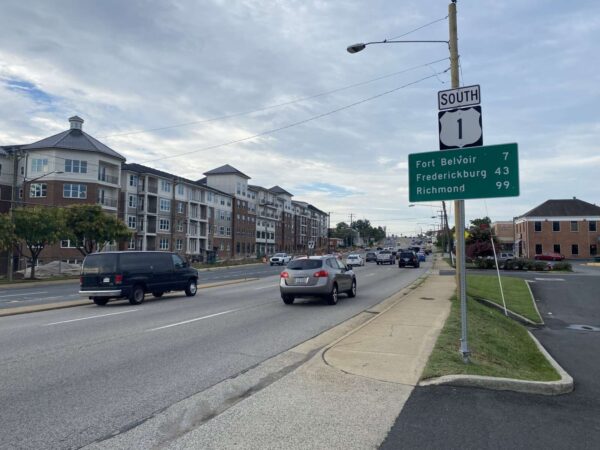
(Updated 10:55 a.m. on 7/26/2023) The ongoing redevelopment of Richmond Highway (Route 1) in Fairfax County has sparked a larger discussion over whether the benefits of road widening projects outweigh their potential harm.
The Virginia Department of Transportation plans to bring improvements to a three-mile stretch in the Richmond Highway corridor in two phases: first from Jeff Todd Way to just north of Frye Road, then from just north of Frye Road to Sherwood Hall Lane.
Notably, the changes will widen Richmond Highway from four to six lanes, which will pave the way for bus rapid transit in the corridor but has garnered some pushback from local community members.
The Coalition for Smarter Growth, which advocates for more “sustainable” transportation methods such as walking, biking and transit in the D.C. region, claimed in a recent press release that “wider roads fail, and the public knows this.”
CSG’s Northern Virginia Advocacy Manager Sonya Breehey says road widening projects create induced demand, arguing that adding more travel lanes incentivizes more people to drive and increases congestion in the long run, despite offering short-term relief.
“The idea is, we get stuck in traffic, so we add travel lanes,” Breehey said. “It’s easy for a few years, but then those travel lanes fill back up and then everybody’s clamoring again for more road widening. It’s a cyclical problem.”
Rep. Don Beyer, who represents the county’s Route 1 area in Congress, told FFXnow in an exclusive interview that he supports road widening projects.
“I think [road widening projects] are an important part of congestion relief,” Beyer said. “There’s an alternative argument…that they will fill up as fast as you build them. That’s certainly been largely true in the metro D.C. area for a long time…but at the same time, I don’t know if it’s still true today.”
In addition to adding travel lanes, the Richmond Highway project reserves median space for future lanes dedicated to The One, a bus rapid transit system that aims to outpace traditional bus services with dedicated lanes and fewer stops.
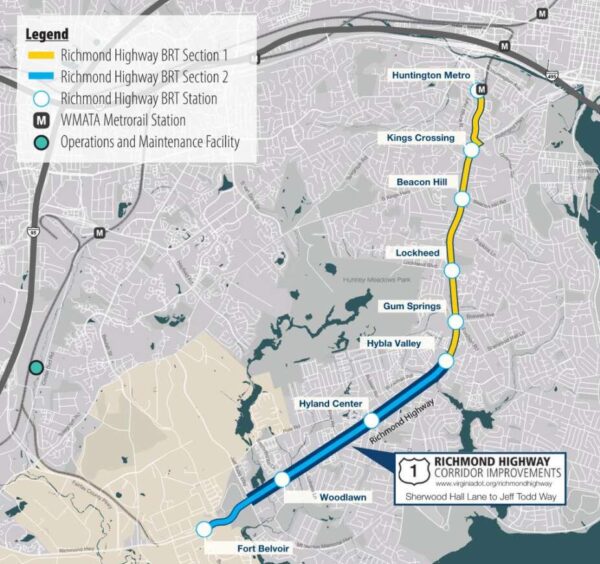
With the BRT expected to be operational in 2030, the Northern Virginia Transportation Commission announced last month that the Commonwealth Transportation Board approved $10 million to help implement the bus system from Fort Belvoir to the Huntington Metro station.
“This billion-dollar investment in a new state-of-the-art transportation system and in the communities along Richmond Highway will revitalize the area and provide more safe, convenient and dependable transportation options for the people who live here,” Mount Vernon District Supervisor Dan Storck wrote in a statement.
Storck says road widening can only be “done right” if it is “in coordination” with “walkable, bikeable communities and mass transit.” Read More
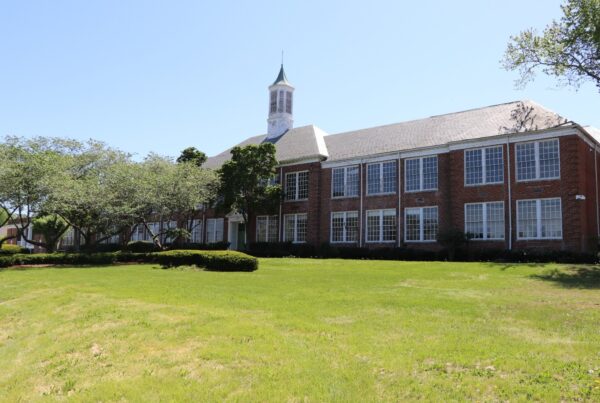
Fairfax County is looking to convert the Original Mount Vernon High School into a collection of public facilities, including possibly an early childhood center, a senior center, a performing arts space and a business incubator.
The Fairfax County Board of Supervisors is seeking a special exception amendment that will allow the county to turn the 84-year-old, now-vacated high school into an accessible public facility with a variety of proposed uses.
Potential uses listed in the application, which was filed last week, include a gym, an early childhood education center, a teen and senior center, a culinary and business incubator, visual and performing arts space, a welcome center, a commercial kitchen for education, and space for nonprofit programs focused on education, career and workforce development and financial literacy.
“Developing a cohesive facility with creative open spaces and classroom areas will nurture these coalitions and support the exchange of ideas and shared innovation,” the application says. “Design concepts will allow for flexibility and adaptability, so the spaces are changeable based on future needs.”
The special exception amendment was actually approved by the Board of Supervisors on Sept. 13, 2022, and a design and site plan are in the works, Mount Vernon District Supervisor Dan Storck reported on June 6.
However, in March, the Virginia Supreme Court struck down the county’s updated zoning ordinance, which created the “Alternative Use of Historic Buildings” category that is the basis of the proposed conversion. The ordinance has since been readopted, but the application has been resubmitted and is going through the approval process again as a precaution, Storck said.
The school’s location in the Mount Vernon District makes it ideal for a multi-use public facility, playing a “critical role” in providing educational opportunities to those in the Route 1 corridor, according to the application.
A special exception is needed to convert the 140,000 square-foot, 22-acre property at 8333 Richmond Highway due to its historical nature.
Once part of George Washington’s original estate, the school opened in early 1940 and its Colonial Revival buildings were constructed under the federal Public Works Administration program. The school was initially only open to white students, due to Jim Crow segregation that was common across Northern Virginia.
The Original Mount Vernon High School is listed on both the Virginia Historic Landmarks Register and National Register of Historic Places.
The county has been planning for its adaptive reuse since at least 2016. The facility is already hosting a renovated and reopened gym, a satellite Fire Marshal’s Office and a Fairfax County Public Schools registration site.
But the county wants to add a lot more. Under the proposal, the building would be in use for up to 17 hours a day, with the early childhood education center opening as early as 6 a.m. and the community spaces closing as late as 11 p.m.
The hope is to design the building so it can accommodate up to 2,000 people on a daily basis, per the application.
To accommodate a requirement that new additions to buildings on the Virginia Historic Landmarks Register “distinguish themselves from the existing historic building,” the welcome center would have an all-glass facade with a small section of red brick.
The application is scheduled for a planning commission public hearing on Sept. 13, which will be followed by a hearing before the Board of Supervisors on Sept. 26.
(Updated 10:30 a.m.) A ribbon will be cut today (Wednesday) on a new, affordable housing development in Hybla Valley.
The Residences at North Hill will get a ceremonial grand opening at 10 a.m. at 7250 Nightingale Hill Lane, hosted by the Fairfax County Board of Supervisors and Fairfax County Redevelopment and Housing Authority. Expected speakers include Board of Supervisors Chairman Jeffrey McKay.
A family and senior housing development with mixed-income levels, the Residences at North Hill consist of 279 one-, two- and three-bedroom apartments across five four-story buildings, according to Pennrose, which developed the project with the nonprofit Community Housing Partners Corporation.
The development includes one building of 63 apartments reserved for people aged 55 and older.
The apartments are priced at 30% to 60% of the area median income, which is “roughly $29,900 to $59,820 for a one-person household,” a media release from the Fairfax County Office of Public Affairs says.
Under construction since 2020, the project furthers the county’s goal set in 2022 to create 10,000 affordable housing units by 2034.
It demonstrates the county’s usage of “creative strategies” to ensure affordable housing “despite the current economic realities of high land prices, inflation, and other barriers to entry,” Fairfax County Department of Housing and Community Direct Tom Fleetwood said by email.
“I believe housing for all is important to our vibrant, diverse and engaged community,” Mount Vernon District Supervisor Dan Storck told FFXnow by email. “Affordable, senior and market-rate homes are all important elements to ensure that everyone who wants to live in the Mount Vernon District can do so, one of my main goals with the redevelopment of the Richmond Highway Corridor.”
Spanning roughly 33 acres off of Richmond Highway (Route 1), the project is part of the Woodley-Nightingale Redevelopment area, now known as North Hill. The FCHRA first acquired 48 acres of the area in 1981, putting it at odds with residents of an existing mobile home park.
Part of the land was redeveloped as the Woodley Hills Estates mobile home community on Dart Drive, according to the county.
“The remaining 33 acres are now the vibrant, new mixed-income, mixed-tenure type intergenerational community the Richmond Highway needs and deserves,” Fleetwood wrote.
In addition to the 279 affordable apartments, the North Hill community includes 175 market-rate townhouses along Dart Drive, a 12-acre public park, playground and a recreational plaza.
The park, set to open later this summer, will offer parking, trails, an open lawn, basketball court, pickleball courts, picnic pavilion and fitness area. The public plaza, located at the corner of Richmond Highway and Dart Drive, features benches, a lawn, fitness equipment, ping pong and chess tables and a potential bus rapid transit station stop.
The proposed stop will be part of The One, the planned public bus system on Richmond Highway that aims to outpace traditional bus services with dedicated lanes and projects. The BRT is expected to be operational in 2030.
The county’s Embark Richmond Highway Comprehensive Plan “encourages future residential and commercial development around the proposed BRT stations so that residents and workers can walk to transit and other daily needs in a mixed use environment,” according to Fleetwood.
“The Bus Rapid Transit system is the catalyst for the revitalization of the Richmond Highway Corridor, from 70’s era development sprawl to a 21st century, modern, higher-density, transit focused, walkable, livable community,” Storck wrote.
On its project website, developer Pennrose notes that North Hill also provides residents easy access to public services, with banks, pharmacies, health care services and grocery stores located within half a mile of the site.
Inova Mount Vernon Hospital will open a new behavioral health unit next week, marking an expansion of mental health care along the Richmond Highway corridor.
A ribbon-cutting ceremony was held yesterday morning (Tuesday) for the nearly $10 million facility, which will increase bed capacity at the hospital by 67%.
Close to $4 million was donated by Amyia and Jeff Veatch, a local entrepreneur who founded the engineering firm Apex Systems. The family previously donated money to help modernize the hospital’s emergency room.
Hospital leaders and a number of elected officials attended the ceremony, including Rep. Don Beyer, State Sen. Scott Surovell, Del. Paul Krizek, Mount Vernon District School Board Rep. Karen Corbett Sanders, and Mount Vernon District Supervisor Dan Storck (who had to leave to vote on the county budget).
The Inova Veatch Family Behavioral Health Unit will open to hospital patients on May 16. It will feature 20 additional beds, private rooms, “quiet” spaces, modernized equipment, and enhanced safety features, like impact resistance windows and drywall.
Along with the hospital’s existing adult psychiatric unit, the total capacity for behavioral health patients will now be 50 beds.
As many noted during the ceremony, mental health care and behavioral services have become a priority in Fairfax County, as rates of depression and suicidal thoughts, specifically among young people, have risen drastically in recent years.
“We have a significant shortage of mental health services all over Virginia and especially acute here in Northern Virginia,” Surovell, who represents Hybla Valley, Woodlawn, and parts of Franconia, told FFXnow. “That’s the big reason we need to expand these services. If you don’t have a place for people to go when they need help, it can result in really tragic consequences.”
He called private contributions like the one made by the Veatch family “critical” to expanding care, particularly since behavioral services “are often not the most profitable areas for a hospital to invest in.”
But he said it’s also on the state to make the necessary investments as the need for mental health care continues to skyrocket.
Virginia Gov. Glenn Youngkin has proposed $230 million in this year’s budget for addressing gaps in behavioral health services. Surovell said that doesn’t go far enough.
“This is about half of what we need because the state is so far behind in investing in behavioral health,” he said.
Mount District Supervisor Dan Storck agreed, stating at the ribbon-cutting that “we’ve never done enough” to provide mental health care both locally and across the country. Adolescent care in particular is lacking, he told FFXnow.
“We need more adolescent psychiatry units. Our adolescents are bearing the brunt of Covid,” Storck said. “They need more support than we can provide. Inova is stepping up in their Fairfax hospital, but that’s still inadequate to our adolescent needs.”
Beyer shared that his son suffers from schizophrenia and has been hospitalized “many times” at Inova Mount Vernon Hospital. The additional unit will hopefully provide care to more people in need like his son, he said.
While more resources are needed, the Veatch behavioral health unit and emergency room are potentially life savers for residents of the Richmond Highway corridor, Surovell said.
“They don’t have to travel to either Alexandria [City] or Franconia or Fairfax to get these services,” he said. “Having a facility that’s close can be the difference between life or death for a lot of people.”
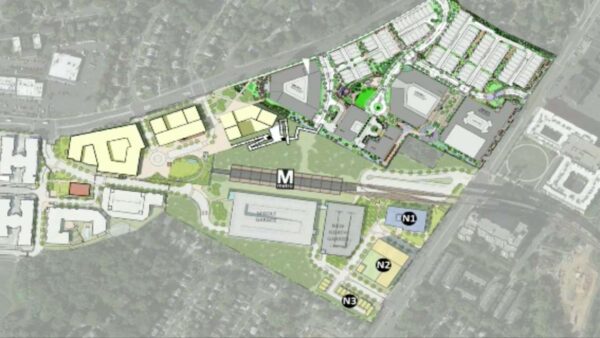
Trees, steep hills, pedestrian paths, building heights, and townhomes were the most talked-about elements during last week’s discussion about the redevelopment of the Huntington Transit Station Area.
At the Oct. 19 Planning Commission meeting, commissioners and the public weighed in with their thoughts and concerns on the proposed revamp of the Huntington Transit Station Area (TSA).
The staff’s comprehensive plan amendment calls for mixed-use development including 382,000 square feet of office, retail, and community-use space, the possibility of a hotel with conference facilities, and 1,500 residential units. 15% of those units at “minimum” should be affordable, the report notes.
A bus rapid transit station is also being called for with a “large, publicly accessible civic plaza” above the station. Plus, more urban park space and “a network of high-quality pedestrian and bicycle paths” connecting to the transit stations and other amenities are also being recommended.
To make room for the redevelopment, it’s being asked that the northern parking garage be torn down.
While a decision was delayed until Nov. 16 on if to approve the comprehensive plan, a lengthy discussion ensued at last week’s meeting. The conversation included the commissioners, county staff, the Mount Vernon Site-Specific Plan Amendment (SSPA) Task Force, Washington Metropolitan Area Transit Authority (WMATA), and the public.
The discussion focused prominently on the site’s challenging topography, the possible addition of townhomes on the northeastern side of the project, preserving a tree buffer, the potentially costly addition of one particular pedestrian path, and building heights.
There are a number of engineering challenges associated with the project mostly due to the Huntington Metro station being located on a steep hill.
“The most significant and defining feature of this site is the grade, from north to south. The highest point of the site is in the southern end on N. Kings Highway and it’s approximately 160 above sea level,” said Graham Owen from the county’s Dept. of Planning and Development. “In contrast, the lowest point of the site is on the northern portion along Huntington Ave and that’s at approximately 30 feet above sea level. So, there are about 130 feet of grade change along the site.”
This extra layer requires adaptation, both in terms of engineering and user experience, particularly when it comes to the building of roads, pedestrian pathways, and buildings.
“That is a hill like you’ve never seen…if you want to work out, run up and down North Kings Highway,” Franconia District Commissioner Dan Lagana noted with a laugh in midst of a discussion about how best to build paths for pedestrians.
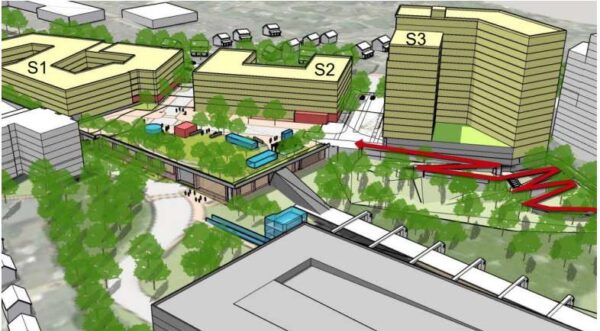
This challenge also relates to building height. If buildings on the southern end of the site are allowed to go up to the maximum allowable height of 200 feet, they could look a lot taller to those seeing the buildings from the north. This was a point of concern for several residents that spoke during the public hearing portion.
“I’d like them to really think about the height of a [200-foot] building. We can already see the parking garage over the tops of the trees,” said one resident. “If they are going to put something that’s two or three times taller than what’s already there, we will have a loss of complete privacy. I’m not opposed to development, but I don’t think that’s great development for people who have bought homes [there].”
Also, in the northeastern portion of the site, there’s currently a tract of trees that has become the subject of perhaps the most significant disagreement about the comprehensive plan.
The tract of trees near the intersection of Huntington Ave and Biscayne Drive acts as essentially a buffer between the townhomes along Biscayne Drive and the Metro station. It’s also where WMATA has proposed selling the land to a developer to build more townhomes.
Steven Segerlin, WMATA’s director of real estate and station area planning, noted that the major barriers to this project – at least from WMATA’s perspective – are financial.
“Based on initial estimates, construction costs… will be significantly greater than the revenue generated by the private developers that could possibly help pay for them,” he said.
Because of this, WMATA wants to sell the land where the trees are to developers for the building of townhomes. Both the staff report and the Mount Vernon SSPA Task Force proposed keeping the trees.
“Giving the high cost for public infrastructure needed to address the area’s lack of connectivity, the Huntington Metro site needs to generate as much revenue as possible to help pay for them,” said Segerlin. “The loss of the townhome development potential significantly reduces that revenue potential and will increase the gap funding request to the county, state, and federal government.”
He further noted that not only does Metro not have the funds to make up this gap, but the agency’s “policy does not allow it.”
Ellen Young of the Mount Vernon SSPA Task Force expressed surprise at this WMATA request. She noted, along with several residents and staff, how the trees are an important buffer between the homes already there and the Metro station. In addition, they are needed to help ease stormwater concerns in a part of the county that does have flooding.
“We had all agreed to the fact that the trees were going to stay there. And that agreement included WMATA,” said Young. “So, I think we were all caught a little off guard tonight.”
Also, a subject of concern from WMATA was a certain pedestrian path that would lead from the condo community Huntington Club to the southern portion of the development. The agency asked it not to be a “requirement” for the entire plan to move forward.
Between dealing with the steep hill and the need to potentially also build also through a grove of trees, the expense could end up being great noted Segerlin. Both staff and the task force appeared to agree that the one path was likely to be more difficult to develop and seemed open to moving forward without it.
Overall, there was considerable agreement on the goals of the comprehensive plan, which is to redevelop the area near the Huntington Metro station to make it denser, more accessible, safer, more inviting, and full of amenities available to the entire Huntington community.
“Development in this area will enhance the character of the community, increase patronage for existing local businesses and lead to reinvestment in the surrounding neighborhoods,” reads the staff report. “The area will become a place where county residents can live, work and shop without excessive dependence upon the automobile, thus realizing some of the county’s key policy objectives.”
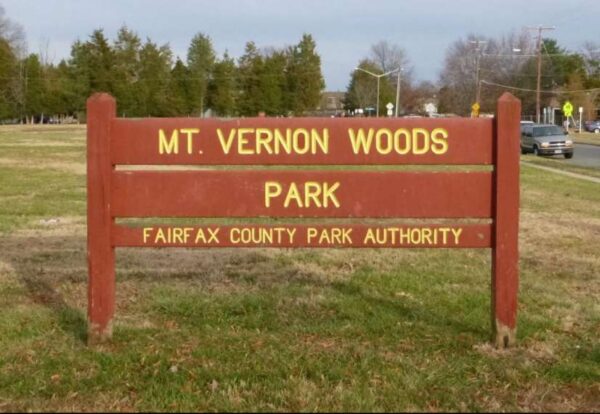
Mount Vernon Woods Park is set to add a playground, picnic shelter, multisport court, a field, and a skate park.
Design work is underway on the county-owned, 7-acre park on the southeast side of Huntley Meadows Park in Hybla Valley. The proposed improvements are based on the park’s 2015 master plan, which calls for a number of additions including a playground, a half-court, a skate park, on-site parking, a pavilion, and an open playing field.
The project is set to cost $2.5 million, which will come from the 2020 park bond, Fairfax County Parks Authority (FCPA) spokesperson Judith Pedersen told FFXnow in an email.
More detailed designs will be presented at a public meeting set for Sept. 8 at Mount Vernon Elementary School just south of the park.
The community will have a chance to comment on the designs both at the meeting and via email until Oct. 10.
The master plan was developed seven years ago to upgrade the 1960s-era park. The goal was to build “new, active facilities to be located in the park closer to Fielding Street to help create a more active and family-friendly park.”
A “neighborhood-scale skate park” is proposed in the southeast corner of the park with features for “both experienced and less-experienced users,” per the plan. This would be only the third county-maintained skate park.
Also proposed is a multi-use half court that could be used for activities like “basketball practice, one-on-one games, four square, hopscotch, or as an area for young children to practice riding a scooter or bike.” A fitness cluster, interpretive signs, and an open playing field are also part of the 2015 plan.
The master plan notes the need to upgrade access to the park as well, which currently doesn’t have easy pedestrian access, on-site parking, and out-of-date facilities.
FCPA has hired the engineering consulting firm Kimley-Horn, which has experience in the county, to assist with the development of the plans.
The designs that will be proposed next month to the public “generally follow” the approved 2015 Master Plan and any differences are “very minor,” Pedersen said.
A construction timeline and schedule will also be presented at the meeting in September.
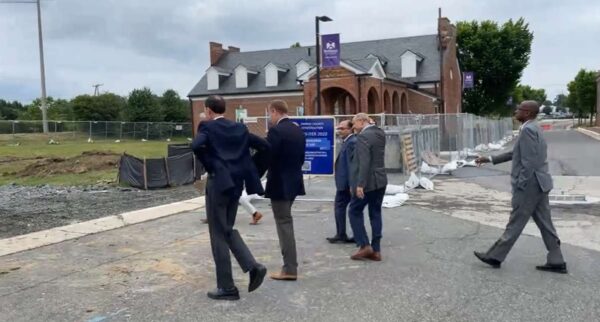
Construction is underway on Fairfax County’s latest effort to remake the former Lorton Reformatory grounds into a destination for local residents and tourists.
Board of Supervisors Chairman Jeff McKay, Mount Vernon District Supervisor Dan Storck, and other local officials broke ground Friday (June 24) on a renovation of two buildings — designated W13 and W15 — that once housed prison inmates.
Located along Ox Road on the west side of the 52-acre site, now known as the Workhouse Arts Center, the 4,500-square-foot buildings will get their brick exteriors restored, while their interiors are overhauled for future commercial tenants. The county has its fingers crossed for a restaurant or brewery.
“We hope that it provides food and beverage opportunities and places for people to come here and spend more time, not just to stop off, but spend the better part of the day exploring the Workhouse,” McKay said. “These buildings will go a long way to doing that.”
Funded by a $6.3 million county investment, the project will also transform the open space between the buildings into a plaza with a boardwalk, raised walkways, seating areas, trees, and new paved paths along Ox Road.
It’s part of a larger plan to redevelop the former prison complex that has been in place since July 2004.
Opened to the public in September 2008, the Workhouse Arts Center now consists of 11 restored buildings that feature art galleries, studios, classrooms, facilities for ceramics and other crafts, and the Lucy Burns Museum, which delves into the Lorton prison’s history.
Additional amenities envisioned for the campus include housing for resident artists and performers, an amphitheater or music hall, a 450-seat theater, a 300-seat performing arts center, a 600-seat events center, and an outdoor garden with a greenhouse.
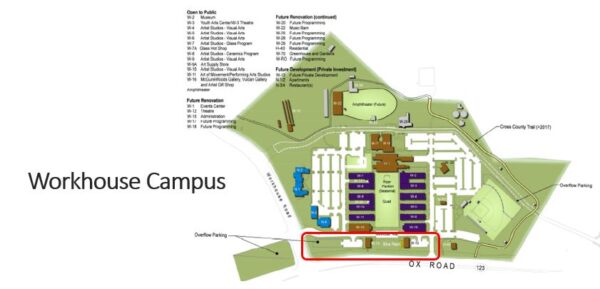
The W13 and W15 buildings have been approved for eating establishments with a total of 400 seats. Read More
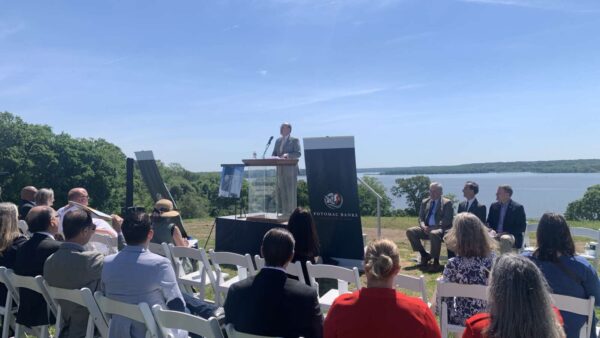
Visit Fairfax is exploring the idea of a tourism improvement district, which could mean an added fee to hotel stays and other amenities.
The tourism organization’s president and CEO, Barry Biggar, said the proposal could go to the Fairfax County Board of Supervisors for a vote this September. The fee would go toward marketing the region, in accordance with a General Assembly law passed last year.
Biggar says southern Fairfax County will be targeted for the district, which would act on its own authority and set fees that could vary for different business types. It would mark a first for the county and could be a model for other areas, he said.
“That money then is collected, accumulated and used purely for the purpose of marketing, promoting the area…which collects the money, but also capital development and capital improvement,” Biggar told FFXnow.
The move could generate an estimated $1 million per year from hotels and restaurants, Biggar said.
It comes amid a county effort to revitalize and rebrand the Route 1 corridor. So far, that push has brought promises of bus rapid transit and a “Potomac Banks: Explore Fairfax South” tourism campaign with a discount pass for historic sites, partnering businesses and more.
“Only the hotels here in the area would be included, so that wouldn’t be added to a Tysons hotel,” Biggar said of the possible fee. “For a hotel, they may go, ‘We’ll do a dollar a room per night.’ For a restaurant, they may go…a half a percent of the total bill. For an attraction, you know, maybe 50 cents per admission.”
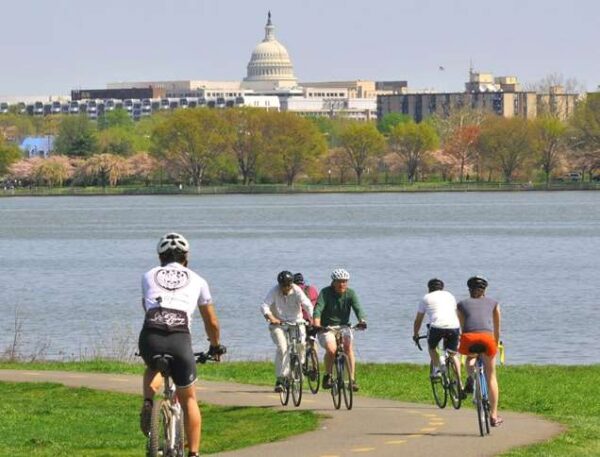
An iconic resource along the Potomac River is turning 50.
The Mount Vernon Trail first opened on April 15, 1972. Half a century later, elected officials and others will gather to celebrate its storied history with activities for all ages.
Scheduled for 10 a.m. to 1 p.m. this Saturday (April 16), the 50th anniversary event at Daingerfield Island (1 Marina Drive) in Alexandria will feature giveaways, work demos, the National Park Service’s Junior Ranger Program, and more, according to an event page.
“The creation of the Mount Vernon Trail exemplifies how determined community members can help foster partnerships with government and the private sector to create a community asset that benefits all of us,” Mount Vernon Supervisor Daniel Storck said during a Fairfax County Board of Supervisors meeting yesterday (Tuesday).
The Friends of the Mount Vernon Trail credits volunteers as instrumental in creating the multi-use path, which now spans more than 18 miles across Fairfax and Arlington counties and Alexandria City:
On April 15, 1972, the first 4.5-mile stretch of the Mount Vernon Trail opened to the public. The gravel path ran from Belle Haven in Alexandria to the Memorial Bridge in Arlington and was the brainchild of two Alexandria women, Ellen Pickering and Barbara Lynch. In 1971, the two gathered over 700 signatures on a petition to create a trail alongside the George Washington Memorial Parkway.
The National Park Service was sympathetic to the plea and agreed to provide the right-of-way, gravel, and tools if Pickering and Lynch could provide volunteers to do the work. So Pickering and Lynch organized 40 volunteers, and every Saturday that winter they spread gravel. In total, 400 recruits spread 4,200 tons of gravel, contributing 5,300 hours of labor to start the trail that would become a vital recreational and transportation corridor in the region.
Storck said the trail serves as an essential artery for the Mount Vernon District, an 18.5-mile anchor for the region’s trail network with approximately 1 million annual users.
In addition to Storck, speakers at the celebration will include:
- George Washington Memorial Parkway Superintendent Charles Cuvelier
- Friends of the Mount Vernon Trail President Judd Isbell
- Arlington County Board Chair Katie Cristol
- Alexandria City Councilmember Sarah Bagley
Several community, transportation, and governmental groups are also expected to attend, including BikeArlington, WalkArlington, Capital Bikeshare, GO Alex, East Coast Greenway, Capital Trails Coalition, Friends of Dyke Marsh, and the Rosslyn Business Improvement District.
The event is free and open to the public.
The first 4.5 miles of the Mount Vernon Trail opened 50 years ago. Join us for a celebration this Saturday and visit the @TrailsCoalition table to see how the MVT will be part of an 881 mile trail network in the future. Details and registration are at https://t.co/pn7Aq6OJX6 pic.twitter.com/CkdeXlqgUU
— Friends of the Mount Vernon Trail (@MtVernonFriends) April 13, 2022
Photo via National Park Service

